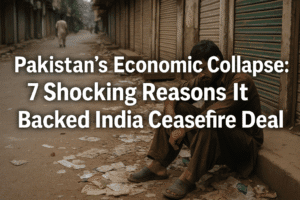Pakistan’s Economic Collapse: 7 Shocking Reasons It Backed India Ceasefire Deal
Amid escalating tensions, India and Pakistan agreed to halt military operations on May 10, 2025, following India’s retaliatory Operation Sindoor targeting terror camps in PoK. RPG Enterprises Chairman Harsh Goenka had earlier warned that Pakistan’s economy—already crippled by depleted forex reserves, 30% inflation, and reliance on a fragile IMF bailout—risked collapse if conflict persisted. Beijing’s reluctance to back a “losing bet,” potential civil unrest, and global isolation further underscored Pakistan’s vulnerabilities.
India’s calibrated strikes, framed as a “wounded nation’s resolve,” combined with diplomatic warnings, highlighted its leverage. The truce, though tentative, reflects how economic realities—not just military strategy—steer modern conflicts. For Pakistan, avoiding war may be less about restraint and more about survival, as financial instability now dictates geopolitical choices. This episode underscores a critical lesson: in an interconnected world, economic resilience shapes national security as profoundly as battlefield strength.

Pakistan’s Economic Collapse: 7 Shocking Reasons It Backed India Ceasefire Deal
In a pivotal development, India and Pakistan announced a mutual agreement to halt military operations across land, air, and sea effective 5:00 PM IST on Saturday, May 10. The decision, confirmed by Indian Foreign Secretary Vikram Misri, follows days of escalating hostilities after Pakistan’s retaliatory shelling in border regions and India’s targeted counter-terror operation, Sindoor. Amid the turmoil, RPG Enterprises Chairman Harsh Goenka spotlighted the economic perils Pakistan could face if tensions spiraled into protracted conflict—a perspective that underscores how financial vulnerabilities may have influenced the path to de-escalation.
The Economic Warnings That Echoed Beyond Battlefields
Hours before the ceasefire announcement, Goenka, a prominent Indian business leader, outlined seven critical risks Pakistan might confront in a prolonged war. His analysis, shared on social media, resonated widely, emphasizing how economic instability could overshadow military posturing:
- Collapsing Forex Reserves: Pakistan’s dwindling foreign exchange reserves (reportedly below $4 billion pre-conflict) would face rapid depletion, crippling imports of essentials like fuel and food. A drawn-out conflict could exacerbate this, triggering hyperinflation and supply chain breakdowns.
- IMF Lifeline at Risk: The International Monetary Fund’s $1 billion bailout package, part of a broader reform program, hinges on political stability. War would violate IMF conditions, jeopardizing future disbursements and alienating global creditors.
- China’s Calculated Distance: While Pakistan’s alliance with China is strategic, Goenka noted Beijing’s reluctance to back “losing bets.” China’s massive Belt and Road investments in Pakistan (notably CPEC) might face reassessment, given its own economic pressures and desire to avoid regional instability.
- Civil Unrest: With inflation already soaring above 30%, war expenditures could ignite public anger. Protests over food shortages and unemployment might destabilize the government, as seen during Sri Lanka’s 2022 crisis.
- Military Reputation at Stake: Pakistan’s army, already facing domestic criticism over economic mismanagement, risks global reputational damage if outmatched by India’s larger, tech-driven forces.
- Blowback from Militant Groups: Goenka warned that Pakistan-based extremist factions, historically state-supported, could turn rogue, destabilizing internal security—a concern validated by past incidents like the TTP’s resurgence.
- Diplomatic Isolation: India’s strengthened ties with the U.S., EU, and Gulf nations mean Pakistan could face intensified sanctions, reduced trade, and diminished diplomatic leverage.
Operation Sindoor: Catalyst for De-escalation?
India’s surgical strikes on terror camps in Pakistan-occupied Kashmir (PoK) on May 7, dubbed Operation Sindoor, marked a turning point. Goenka described it as “the voice of a wounded nation,” referencing the Pahalgam attack that killed 26. However, the precision operation also underscored India’s capability to retaliate without full-scale war—a message that may have pushed Pakistan toward dialogue.
Why Business Leaders Are Weighing In
Goenka’s intervention highlights a growing trend of corporate figures influencing geopolitical discourse. For businesses, regional stability is vital for supply chains, investments, and market access. His warnings reflect concerns shared by global investors: conflict disrupts trade, spikes insurance costs, and scares foreign capital. Notably, India’s emphasis on Pakistan’s economic frailty during negotiations reveals how financial pressures can be leveraged in diplomacy.
The Ceasefire’s Unspoken Truths
While the agreement halts immediate hostilities, it stops short of a formal ceasefire, indicating fragile trust. India’s stern warning—that future terror attacks will be deemed “acts of war”—suggests economic deterrence is now central to its strategy. For Pakistan, averting conflict may stem from necessity: with inflation, debt, and energy crises mounting, war could indeed be the coup de grâce for its economy.
Lessons for Conflict Resolution
This episode underscores how economic interdependence and vulnerabilities shape modern conflicts. As global institutions and allies prioritize stability, nations on the brink are compelled to weigh military ambitions against financial survival. For Pakistan, recalibrating its stance may be less about diplomatic goodwill and more about economic inevitability.
Conclusion
The India-Pakistan détente, while tenuous, offers a case study in how economic realities can temper aggression. As Goenka’s analysis illuminates, the true cost of war extends beyond battlefields—into currencies, trade networks, and the lives of ordinary citizens. In an era where markets often dictate margins of power, fiscal resilience may prove as critical as military might.
You must be logged in to post a comment.